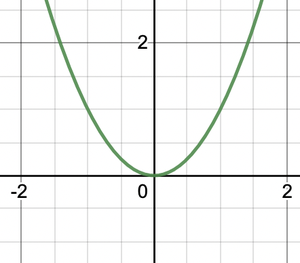功能组成
函数就像盒子或机器,它们接受一些输入,对其进行一些处理,然后输出输出。通常,它们以某种数字格式接受输入并给出输出。函数非常重要,在数学领域中使用非常频繁。它们允许我们在一个盒子中定义一些数学处理,然后在我们喜欢的任何地方使用该盒子,而无需一次又一次地考虑计算。通过这种方式,它们简化了我们构建复杂事物的计算和思考过程。
职能
该函数可以定义为对某个数学数字进行运算以给我们输出的规则。但是,没有必要将对某些数字进行运算以给出某些输出的每个规则都放在函数的类别中。规则必须满足某些条件才能称为函数。
A function is a rule which maps an input number to another number which is called output of the function.

例如,f(x) = x + 3 可以被认为是一个函数,它接受一个输入,将其增加 3,然后给出输出。数字“x”称为函数的参数。当参数选择为 x = 2 时,函数给出的输出为 5。
似乎可以选择任何数字作为参数,但事实并非如此。稍后我们将重点介绍该案例。
函数图
可以通过获取不同的输入值并在它们上找到函数输出来绘制函数图。让我们考虑一个函数
f(x) = x 2
f(-2) = 4, f(-1) = 1, f(0) = 0, f(1) = 1 和 f(2) = 4。现在让我们在图表上绘制这些值。

函数的域和范围
一个函数不能有一个输入值给出两个输出。这违反了函数的定义。有一些值可以作为函数函数地给出输出。在决定哪些值作为输入有效时,我们需要记住,在任何输入上,函数都不应变为未定义或在输出中给出虚数。
Domain: Set of all possible input to the function.
Range: Set of corresponding outputs by the function.
例如,让我们考虑函数f(x) = ![]()
现在已知平方根不能将零作为输入。因此,函数的域是除零以外的所有实数值,即R – {0} 。该函数的输出可以是任何东西,因此范围是所有实数,即R 。
功能组成
通过使用组合的过程,可以从看似简单的函数构建复杂的函数。在这个过程中,一个函数的输出作为另一个函数的输入。考虑两个函数 f 和 g。这两个功能的一种组合可以是,
g(f(x)) = gof(x)
这意味着,输入给 f(x),其输出作为输入给 g(x)。另一种组合方式可以是,
f(g(x)) = 雾(x)
如果 f(x) = x 2和 g(x) = x + 3。组合 g(f(x)) 将是,
g(f(x)) = g(x 2 ) = x 2 + 3
类似地,f(g(x)) = f(x + 3)= (x + 3) 2
请注意,g(f(x)) 不等于 f(g(x))。函数的组合也称为函数的函数。
功能组合的领域和范围
不可能组合任何两个函数,例如某些函数不能组合在一起,例如 f(x) = ln(x) 和 g(x) = -x 2 。如果我们尝试合成 f(g(x)),这是不可能的,因为对数函数不能接受负输入值,所以 f(g(x)) 是不可能的。因此,在决定编写函数时应牢记某些事项。
在另一种情况下,假设 f(x) = √x 和 g(x) = log(x)。在这种情况下,f(x) 的域是正实数。因此,在 f(g(x)) 的情况下,我们需要确保 log(x) 不会给出负值作为输出。因此,f(x) 的范围应该在 g(x) 的范围内。
For some pair of functions, it is not possible to make a composite function out of them. For other pairs, the domains can be modified. In such cases following things should be kept in mind:
- In the case of f(g(x)), the range of g(x) must lie inside the domain of f(x).
- Domain of g(x) should be modified such that the range of g(x) lies inside the domain of f(x).
Domain of the composed function is either same as the domain of the first function or else lies inside it. The range of the composed function is either the same as the range of the second function, or else lies inside it.
让我们看看这些概念的一些问题。
示例问题
问题 1:对于给定的函数 f(x) = e x和 g(x) = x 2 + 1。找出 f(g(x) 和 g(f(x)) 的值。
解决方案:
The domain of both the functions are real numbers, so there is no need to modify the domain for the first function in any case.
fog(x)
f(g(x))
⇒ f(x2 + 1)
⇒
gof(x)
g(f(x))
⇒g(ex)
⇒(ex)2 + 1
⇒ e2x + 1
问题 2:对于给定的函数 f(x) = x 3和 g(x) = x 2 + 1。找出 f(g(x) 和 g(f(x)) 的值。
解决方案:
The domain of both the functions are real numbers, so there is no need to modify the domain for the first function in any case.
fog(x)
f(g(x))
⇒ f(x2 + 1)
⇒ (x2+1)3
gof(x)
g(f(x))
⇒g(x3)
⇒(x3)2 + 1
⇒ x6 + 1
问题 3:对于给定的函数 f(x) = 2x 和 g(x) = x 2 + 1。找出在 x = 2 时 f(g(x) 和 g(f(x)) 的值。
解决方案:
The domain of both the functions are real numbers, so there is no need to modify the domain for the first function in any case.
fog(x)
f(g(x))
⇒ f(x2 + 1)
⇒ 2(x2 + 1)
At x = 2
f(g(x)) = 2(4 + 1)
⇒f(g(x)) = 10
gof(x)
g(f(x))
⇒g(2x)
⇒(2x)2 + 1
⇒ 4x4 + 1
At x = 2
⇒ 4(24) + 1
⇒ 4(16) + 1
⇒ 65
问题 4:对于给定的函数 f(x) = sin(x) 和 g(x) = x 2 。找出fog(x) 和gof(x) 的域和范围。
解决方案:
f(x) has domain as all real numbers and range [-1,1]. While g(x) has domain all the real numbers and range R+.
fog(x)
The domain is all real numbers, the range is also all real numbers
gof(x).
The domain is all real numbers, the range is between 0 and 1.
问题 5:对于给定的函数 f(x) = √x 和 g(x) = 3x。找出fog(x) 和gof(x) 的域和范围。
解决方案:
f(x) has domain as all real positive numbers and range is all real numbers. While g(x) has domain all the real numbers and range R+.
fog(x)
The domain is positive real numbers because output of g(x) should not be negative. The range is all real numbers
gof(x).
The domain is all real numbers, the range is all real numbers.
问题 6:对于给定的函数 f(x) = log(x) 和 g(x) = x + 1。找出 f(g(x) 和 g(f(x)) 的值。
解决方案:
The domain of both f(x) is all positive numbers i.e R+ and range is all real numbers. The domain and range for g(x) is all real numbers.
f(g(x))
While doing this, the domain of f(x) must be kept in mind. Output of g(x) must always be positive.
x + 1> 0
⇒ x > -1. So, domain is (-1, ∞)
f(g(x))
⇒ f(x + 1)
⇒ log(x + 1)
The range is all real numbers.
gof(x)
g(f(x))
⇒g(log(x))
⇒log(x) + 1
The domain is R+ and the range is all real numbers.